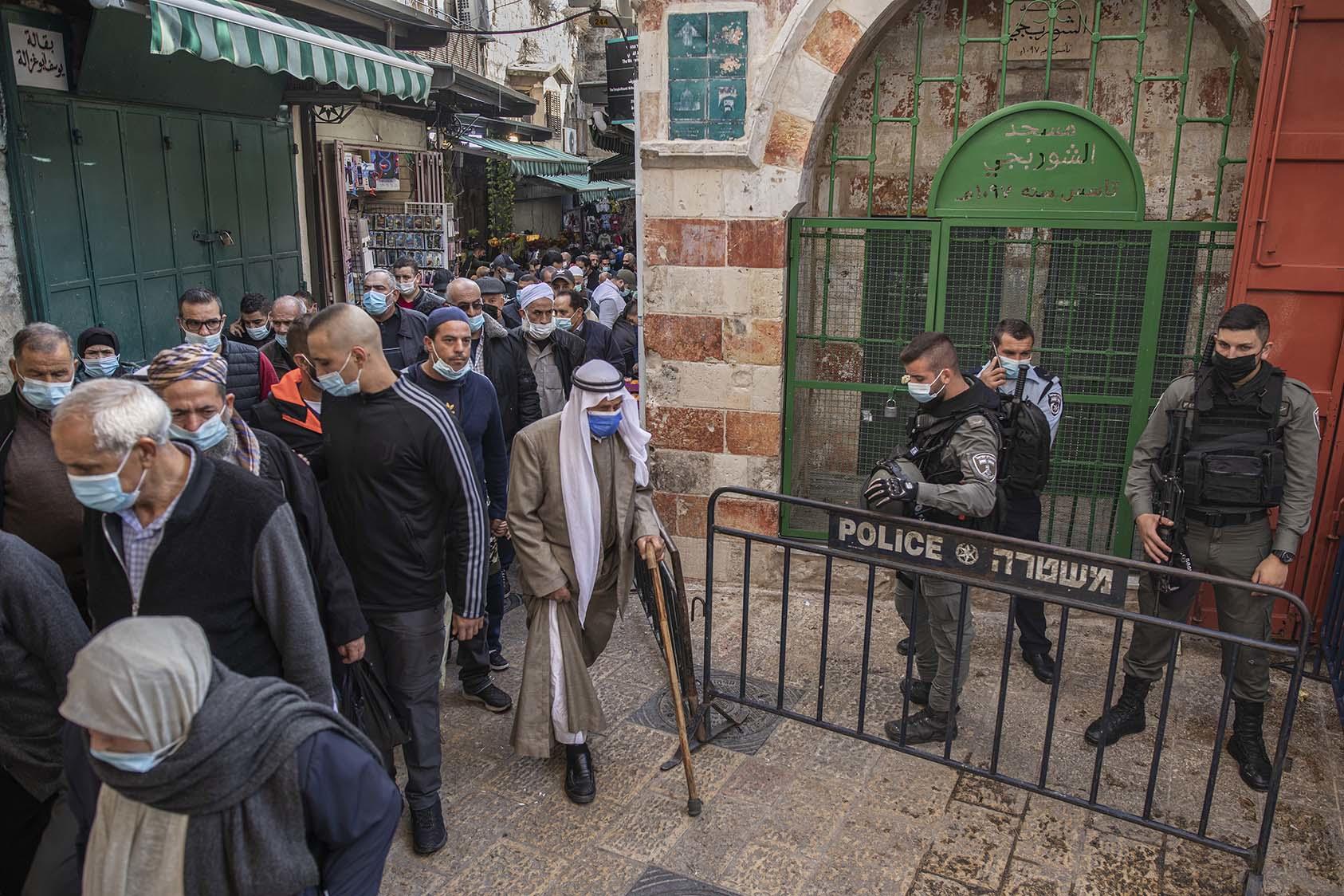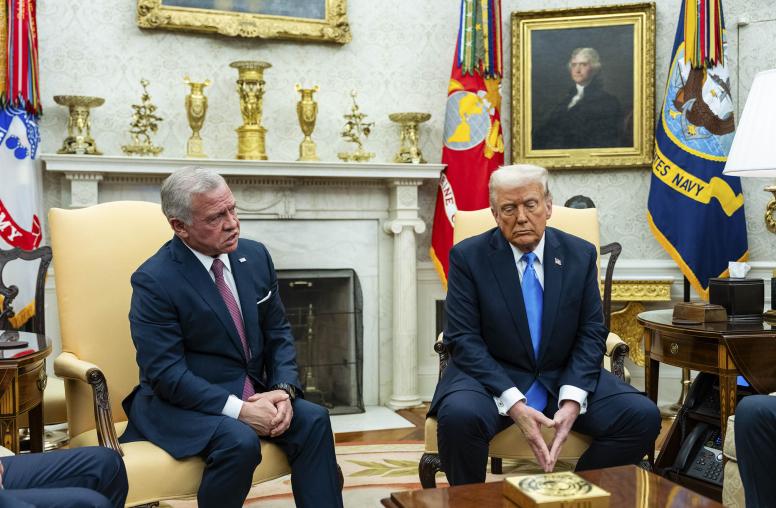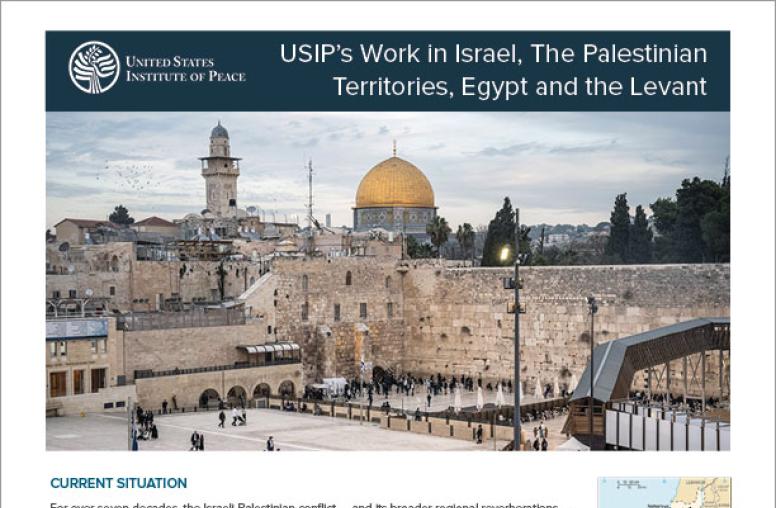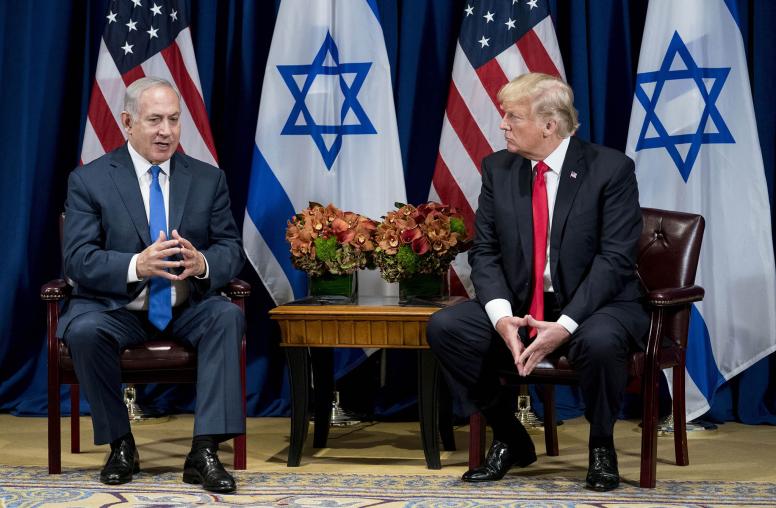The Four Races That Will Define the Future of the Israeli-Palestinian Conflict
To advance peace, the parties must wrestle with troubling trends within and between their societies.
After the latest round of violence this May, Israeli and Palestinian leaders are walking a series of tightropes — Israel’s new government is composed of a potentially unsustainable coalition; a fragile cease-fire teeters between Hamas and Israel; and public protests continue to shake the Palestinian Authority.

The conflict is at a critical juncture, in no small part because of evolving (and troubling) trends within each society. There are four dynamic races being run — involving multiple contenders on each team — between polarization and unity of purpose; between moderation and extremism; between hope and despair; and between stagnation and change. The ultimate victor in each of these races, and how the participants engage toward the finish line, will determine the prospects of future war and peace.
1. A Race Between Polarization and Unity of Purpose
Beyond the longstanding divides of the Israeli-Palestinian conflict, Israelis and Palestinians face the challenge of deepening societal polarization more than ever before. This is happening on four fronts:
- Since 2007, the Palestinians have been primarily divided between support for Fatah and Hamas. This year, however, has witnessed a deepening polarization in the Palestinian body politic, as a result of the postponement of the elections by Palestinian President Mahmoud Abbas, competition over the control of reconstruction after the recent Gaza war, and an underlying rivalry over who is the defender of Al-Aqsa Mosque and East Jerusalem. At the heart of the split are two diametrically opposed strategies: one led by Abbas that argues that negotiations are the only route to achieve peace and a second led by Hamas and Islamic Jihad that firmly believes that the only way to achieve Palestinian aspirations is through armed resistance, arguing that negotiations have not yielded any meaningful results since the Madrid Peace Conference 30 years ago.
- In the four Israeli elections that took place over two years, the Israeli-Palestinian conflict was virtually a non-issue among leaders and citizens. Concurrently, however, two broad camps with competing goals remain. One is for settlement expansion, annexation and the effective, or even the clearly articulated, goal of ending the two-state solution regardless of the impact on future peace prospects. The other sees separation between Israelis and Palestinians through the two-state solution, while ensuring Israel’s security, as the only route to sustainable peace. Within the new Israeli government (the most disparate coalition in the country’s history) there are supporters of both camps. How they will contend with each other remains to be seen.
- Israeli Arabs have also oscillated between unity and division. At the height of their unity, Israel’s Palestinian parties were able to secure 15 seats in the Knesset. However, in the last Israeli election, these parties were divided. In a historic move, the Islamic party Ra’am did not join the Joint Arab List, instead agreeing to negotiate to join the majority coalition to try to serve the interests of its constituents and enable them to deal with the challenges of their daily lives. This resulted in a split among Israeli Arabs — between supporters of Ra’am’s approach and those who believe its decision represents an abandonment of Israeli Arabs’ longstanding refusal to join any Israeli government.
- In May, Israel witnessed cross-communal clashes — unprecedented in scope and magnitude —between Israeli Jews and Israeli Arabs in several mixed cities. For decades, Israeli Arabs have felt that they have been treated as second-class citizens, and this frustration erupted into violence in the wake of clashes in Jerusalem and the war on Gaza. Security forces quelled the violence, but former Israeli president Reuvin Rivlin went so far as to warn that Israel could be on the brink of a civil war. Underlying tensions persist between Arabs and Jews in Israel. The need to mend the social fabric is clear.
2. A Race Between Moderation and Extremism
Extremism has been a hallmark of the Middle East in recent decades. The Israeli-Palestinian conflict is no exception to this trend. Where moderates once comprised the majority, today extremists play a larger role.
Among Palestinians, there are groups who view violence as the only language Israel understands, believing that Abbas’ diplomacy has failed to generate Israeli concessions, while Hamas’ approach has generated concessions such as prisoner exchanges and allowing Qatari money into Gaza.
Israeli far-right extremists — once fringe actors — have also been empowered in recent years, as Israeli public opinion moves further to the right and politicians enter cycles of right-wing political and ideological one-upmanship. This coarser rhetoric is seen in events such as the “Flag March” approved by the new Israeli government, which used slogans that were denounced by the Israeli Foreign Minister Yair Lapid, as primarily an avenue for provocation and harassment of Palestinian Jerusalemites.
3. A Race Between Hope and Despair
After the cease-fire, the U.N. special coordinator for the Middle East peace process told the Security Council that the lack of a political horizon “kills hope and provides space for those not interested in sustainable peace.” The head of UNRWA echoed the same warning, referring to “the death of hope”; adding that “despair is spreading in Palestinian refugee camps beyond the Occupied Palestinian Territory, especially among the youth.”
Polls conducted on Palestinian attitudes regarding the conflict paint a picture of Palestinian despair, and much of the decline of support to the two-state solution among both Palestinians and Israelis has been attributed to the loss of hope that this solution is attainable. Continuing and deepening despair is a recipe for more frequent, intense and brutal cycles of violence.
4. A Race Between Stagnation and Change
This year, large demonstrations took place both in Israel and in the West Bank calling for reform. In the summer of 2020, Israelis demonstrated on a weekly basis calling for Netanyahu’s resignation because of his corruption trial, his handling of the coronavirus pandemic and the ensuing economic fallout at the time.
More recently, Palestinians also took to the street protesting a long list of grievances — from the postponement of elections to bad governance, corruption and more. The latest round of demonstrations — which included calls for Abbas to resign — was sparked by the death of Nizar Banat, a harsh critic of the Palestinian Authority, while in PA custody.
The crackdown by the security forces was quite violent on both Israeli and Palestinian demonstrators.
Getting to the Finish Line
These races are marathons rather than sprints. The teams are comprised of leaderships, publics and regional and international players, all of whom need to coordinate effectively to get to the finish line: two peoples living peacefully and securely alongside one another.
On the Palestinian front: The challenges facing the Palestinians are daunting. Foremost, an effort must be made to agree on a national strategy for their struggle to end the occupation. Such an effort has numerous prerequisites — from conducting a national dialogue, to establishing a national unity government to prepare for elections, to reaching an understanding on the reconstruction of Gaza and starting a reform process to revitalize their institutions and fight corruption. Rebuilding a sense of national unity is a critical aim, as is the need for leadership to build trust and engage honestly with the public about the road ahead and the tradeoffs necessary for peace. Furthermore, the time has come for some form of dialogue between Palestinians and Israeli Arabs.
In dealing with the conflict, the Palestinians must revive the previous formula for negotiations. Hamas and Islamic Jihad were never involved in the negotiations, and it was agreed that the outcome can be either accepted or rejected in a referendum, by a democratically elected parliament, or in another formula agreed upon by the Palestinian factions.
On the Israeli front: The challenges for the Israelis are quite daunting as well. Israelis need to recognize that creeping annexation and settlement expansion stands to end the two-state solution and the Jewish and/or democratic character of the state of Israel. The Israeli vision for an endgame for the conflict needs to be clarified, even if the road to reach that end may be long and difficult. Without a political horizon there will neither be hope nor stability. If there is no justice and respect for the humanity and rights of others, there will be no peace — whether in Gaza, the West Bank, East Jerusalem or even within the green line. In Israel, there is a need for leadership to build trust with publics and engage honestly about the road ahead and the tradeoffs necessary for peace.
The international community must intervene: Over decades, significant steps were rarely achieved in this conflict without extensive external involvement, particularly from the United States. This will remain the case. The Biden administration has stated its readiness to work closely with allies within the region and beyond and should take steps to do so, making a determined effort to achieve the following:
- Reconfirmation of the terms of the endgame in as much detail as is practically feasible.
- Strong support for moderates and weakening the extremists through clear incentives and disincentives. Extremists should be encouraged to moderate positions and given a clear, coordinated and determined signal that failure to do so will carry clear consequences.
- Pressure exerted on both sides to take synchronized reciprocal steps to reduce tension and build confidence.
- Reaching an understanding on the reconstruction of Gaza and a path toward improving lives in both the West Bank and Gaza.
- Support for grassroot peacebuilding efforts to provide hope, particularly to the young, based on real progress on the ground.
The four races in Israeli and Palestinian societies — between polarization and unity of purpose; between moderation and extremism; between hope and despair; and between stagnation and change — reflect grave challenges. But these forces also demonstrate the numerous justified steps that can be reasonably demanded from all sides to contribute to building confidence between the parties and advancing peace. While the context seems bleak, opportunities for improvement still abound.



